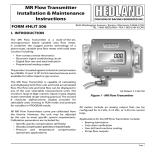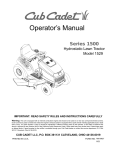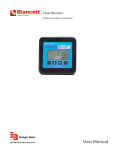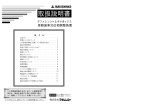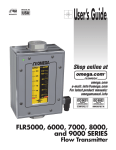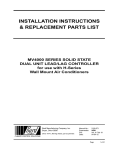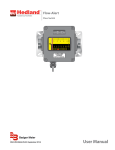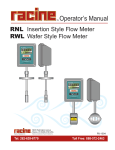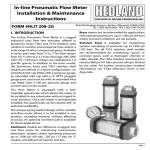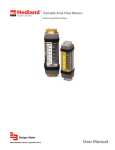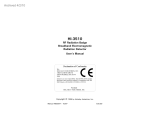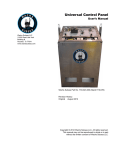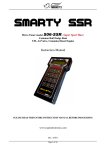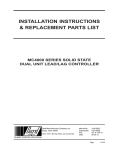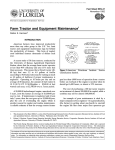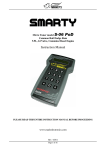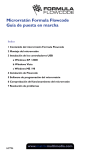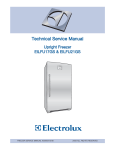Download User Manual - Hedland Flow Meters
Transcript
MR Flow Transmitter RUN Flow Transmitter 3500 PSI/241 BARS MAX OIL XMT-UM-00498-EN-02 (November 2013) User Manual MR Flow Transmitter Page ii November 2013 User Manual CONTENTS Introduction . . . . . . . . . . . . . . . . . . . . . . . . . . . . . . . . . . . . . . . . . . . . . . . . . . . . . . . . . . . . . . . . . . . . . . . . . 5 Safety Information . . . . . . . . . . . . . . . . . . . . . . . . . . . . . . . . . . . . . . . . . . . . . . . . . . . . . . . . . . . . . . . . . . . . . 5 Unpacking and Inspection . . . . . . . . . . . . . . . . . . . . . . . . . . . . . . . . . . . . . . . . . . . . . . . . . . . . . . . . . . . . . . . .5 Installation . . . . . . . . . . . . . . . . . . . . . . . . . . . . . . . . . . . . . . . . . . . . . . . . . . . . . . . . . . . . . . . . . . . . . . . . . . 6 Installation Recommendations . . . . . . . . . . . . . . . . . . . . . . . . . . . . . . . . . . . . . . . . . . . . . . . . . . . . . . . . . . .7 Electrical Connections . . . . . . . . . . . . . . . . . . . . . . . . . . . . . . . . . . . . . . . . . . . . . . . . . . . . . . . . . . . . . . . .7 Schematics . . . . . . . . . . . . . . . . . . . . . . . . . . . . . . . . . . . . . . . . . . . . . . . . . . . . . . . . . . . . . . . . . . . . . . . 8 Installing the Transmitter . . . . . . . . . . . . . . . . . . . . . . . . . . . . . . . . . . . . . . . . . . . . . . . . . . . . . . . . . . . . . 10 Operation . . . . . . . . . . . . . . . . . . . . . . . . . . . . . . . . . . . . . . . . . . . . . . . . . . . . . . . . . . . . . . . . . . . . . . . . . . 12 Operating the Meter . . . . . . . . . . . . . . . . . . . . . . . . . . . . . . . . . . . . . . . . . . . . . . . . . . . . . . . . . . . . . . . . 12 Normal Operation (RUN) Mode . . . . . . . . . . . . . . . . . . . . . . . . . . . . . . . . . . . . . . . . . . . . . . . . . . . . . . . . . 12 Programming Operation (PROGRAM) Mode . . . . . . . . . . . . . . . . . . . . . . . . . . . . . . . . . . . . . . . . . . . . . . . . . 12 Cover Removal/Reinstallation . . . . . . . . . . . . . . . . . . . . . . . . . . . . . . . . . . . . . . . . . . . . . . . . . . . . . . . . . . 13 Programming Procedures . . . . . . . . . . . . . . . . . . . . . . . . . . . . . . . . . . . . . . . . . . . . . . . . . . . . . . . . . . . . . 13 List Item Selection Procedure . . . . . . . . . . . . . . . . . . . . . . . . . . . . . . . . . . . . . . . . . . . . . . . . . . . . . . . . . . 13 Numeric Value Entry Procedure . . . . . . . . . . . . . . . . . . . . . . . . . . . . . . . . . . . . . . . . . . . . . . . . . . . . . . . . . 14 Programming Flow Chart . . . . . . . . . . . . . . . . . . . . . . . . . . . . . . . . . . . . . . . . . . . . . . . . . . . . . . . . . . . . . 14 Maintenance . . . . . . . . . . . . . . . . . . . . . . . . . . . . . . . . . . . . . . . . . . . . . . . . . . . . . . . . . . . . . . . . . . . . . . . . 17 Cartridge Cleaning . . . . . . . . . . . . . . . . . . . . . . . . . . . . . . . . . . . . . . . . . . . . . . . . . . . . . . . . . . . . . . . . . 17 Inspection . . . . . . . . . . . . . . . . . . . . . . . . . . . . . . . . . . . . . . . . . . . . . . . . . . . . . . . . . . . . . . . . . . . . . . . 17 Troubleshooting . . . . . . . . . . . . . . . . . . . . . . . . . . . . . . . . . . . . . . . . . . . . . . . . . . . . . . . . . . . . . . . . . . . . . . 18 No LCD Display . . . . . . . . . . . . . . . . . . . . . . . . . . . . . . . . . . . . . . . . . . . . . . . . . . . . . . . . . . . . . . . . . . . . 18 No Rate or Total Displayed . . . . . . . . . . . . . . . . . . . . . . . . . . . . . . . . . . . . . . . . . . . . . . . . . . . . . . . . . . . . 18 Unstable Flow Reading . . . . . . . . . . . . . . . . . . . . . . . . . . . . . . . . . . . . . . . . . . . . . . . . . . . . . . . . . . . . . . 18 Application Information, Liquid . . . . . . . . . . . . . . . . . . . . . . . . . . . . . . . . . . . . . . . . . . . . . . . . . . . . . . . . . . . . 19 Viscosity Effect (SUS/cSt) . . . . . . . . . . . . . . . . . . . . . . . . . . . . . . . . . . . . . . . . . . . . . . . . . . . . . . . . . . . . . 19 Density Effect (specific gravity) . . . . . . . . . . . . . . . . . . . . . . . . . . . . . . . . . . . . . . . . . . . . . . . . . . . . . . . . . 19 Specifications . . . . . . . . . . . . . . . . . . . . . . . . . . . . . . . . . . . . . . . . . . . . . . . . . . . . . . . . . . . . . . . . . . . . . . . 23 General . . . . . . . . . . . . . . . . . . . . . . . . . . . . . . . . . . . . . . . . . . . . . . . . . . . . . . . . . . . . . . . . . . . . . . . . 23 Materials . . . . . . . . . . . . . . . . . . . . . . . . . . . . . . . . . . . . . . . . . . . . . . . . . . . . . . . . . . . . . . . . . . . . . . . . 24 Flow vs Pressure Drop . . . . . . . . . . . . . . . . . . . . . . . . . . . . . . . . . . . . . . . . . . . . . . . . . . . . . . . . . . . . . . . . . . 29 Petroleum Fluids . . . . . . . . . . . . . . . . . . . . . . . . . . . . . . . . . . . . . . . . . . . . . . . . . . . . . . . . . . . . . . . . . . . 29 Phosphate Ester . . . . . . . . . . . . . . . . . . . . . . . . . . . . . . . . . . . . . . . . . . . . . . . . . . . . . . . . . . . . . . . . . . . 30 November 2013 Page iii MR Flow Transmitter API Oil . . . . . . . . . . . . . . . . . . . . . . . . . . . . . . . . . . . . . . . . . . . . . . . . . . . . . . . . . . . . . . . . . . . . . . . . . 31 Water-Based Fluids . . . . . . . . . . . . . . . . . . . . . . . . . . . . . . . . . . . . . . . . . . . . . . . . . . . . . . . . . . . . . . . . . 32 Water . . . . . . . . . . . . . . . . . . . . . . . . . . . . . . . . . . . . . . . . . . . . . . . . . . . . . . . . . . . . . . . . . . . . . . . . . . 33 Caustic and Corrosive Liquids . . . . . . . . . . . . . . . . . . . . . . . . . . . . . . . . . . . . . . . . . . . . . . . . . . . . . . . . . . 33 Air/Compressed Gases . . . . . . . . . . . . . . . . . . . . . . . . . . . . . . . . . . . . . . . . . . . . . . . . . . . . . . . . . . . . . . . 34 Air/Caustic and Corrosive Gases . . . . . . . . . . . . . . . . . . . . . . . . . . . . . . . . . . . . . . . . . . . . . . . . . . . . . . . . . 34 Page iv November 2013 User Manual INTRODUCTION The MR flow transmitter is a state-of-the-art, microprocessor based variable area flow meter. It combines the rugged proven technology of a piston-type, variable area flow meter with solid state circuitry including: • Non-contact sensor electronics • Electronic signal conditioning circuit • Digital flow rate and total indication • Proportional analog output The product is sealed against industrial contamination by a NEMA 12 and 13 (IP 52/54) rated enclosure and is available for either liquid or gas service. The MR flow transmitter is capable of calculating and displaying both flow rate and total accumulated flow. The flow rate and total flow can be displayed in any of the user selectable measurement units. The monitor’s large 8 digit numeric liquid crystal display makes extended range viewing practical. The second 8 character alphanumeric display provides for selectable units viewing in RUN mode and prompts for variables in PROGRAM mode. All MR flow transmitters come pre-calibrated from the factory. However, the unit may be adjusted by the user to meet specific system requirements. Calibration parameters are included for: • Specific gravity compensation (all fluids) • Viscosity compensation (petroleum-based fluids) • Pressure and temperature compensation (pneumatic applications) All meters include an analog output that can be configured for 0…5V DC, 0…10V DC, or 4…20 mA current loop. Applications for the MR flow transmitter include: • Bearing lubrication • Case drain verification • Gun drill and machine cooling • Pump flow outputs SAFETY INFORMATION The installation of this flow meter must comply with all applicable federal, state, and local rules, regulations, and codes. Failure to read and follow these instructions can lead to misapplication or misuse of this product, resulting in personal injury and damage to equipment. UNPACKING AND INSPECTION Upon opening the shipping container, visually inspect the product and applicable accessories for any physical damage such as scratches, loose or broken parts, or any other sign of damage that may have occurred during shipment. NNOTE: If damage is found, request an inspection by the carrier's agent within 48 hours of delivery and file a claim with the carries. A claim for equipment damage in transit is the sole responsibility of the purchaser. November 2013 Page 5 MR Flow Transmitter INSTALLATION THIS PRODUCT SHOULD BE INSTALLED AND SERVICED BY TECHNICALLY QUALIFIED PERSONNEL TRAINED IN MAINTAINING INDUSTRIAL CLASS FLOW INSTRUMENTATION AND PROCESSING EQUIPMENT. READ INSTRUCTIONS THOROUGHLY BEFORE INSTALLING THE UNIT. IF YOU HAVE ANY QUESTIONS REGARDING PRODUCT INSTALLATION OR MAINTENANCE, CALL YOUR LOCAL SUPPLIER FOR MORE INFORMATION. DISCONNECT ELECTRICAL POWER BEFORE OPENING WIRING ENCLOSURE. FAILURE TO FOLLOW THESE INSTRUCTIONS COULD RESULT IN SERIOUS PERSONAL INJURY OR DEATH AND/OR DAMAGE TO THE EQUIPMENT. ALL WIRING SHOULD BE INSTALLED IN ACCORDANCE WITH THE NATIONAL ELECTRICAL CODE® AND MUST CONFORM TO ANY APPLICABLE STATE AND LOCAL CODES. FAILURE TO FOLLOW THESE INSTRUCTIONS COULD RESULT IN SERIOUS PERSONAL INJURY OR DEATH AND/OR DAMAGE TO THE EQUIPMENT. AIR/GAS METERS ARE NOT OXYGEN CLEANED. USE WITH OXYGEN MAY CAUSE HAZARDOUS OR EXPLOSIVE CONDITIONS THAT MAY CAUSE SERIOUS PERSONAL INJURY AND/OR DAMAGE TO THE EQUIPMENT. THIS METER MAY CONTAIN RESIDUAL AMOUNTS OF TEST FLUID AT THE TIME OF SHIPMENT. THIS FLUID SHOULD BE REMOVED PRIOR TO INSTALLATION AS THE FLUID MAY BE INCOMPATIBLE OR HAZARDOUS WITH SOME LIQUIDS OR GASES. FAILURE TO FOLLOW THESE INSTRUCTIONS COULD RESULT IN DAMAGE TO THE EQUIPMENT. THIS STANDARD METER IS UNIDIRECTIONAL. ATTEMPTS TO FLOW FLUIDS IN THE OPPOSITE DIRECTION OF THE FLOW ARROW WILL RESULT IN THE METER ACTING AS A CHECK VALVE, CREATING A DEADHEADING SITUATION. IF THE DIFFERENTIAL PRESSURE MAGNITUDE IS GREAT ENOUGH, DAMAGE TO THE INTERNAL PARTS OF THE METER WILL RESULT. Page 6 November 2013 User Manual Installation Recommendations The transmitter is a simple device to install. However, the following measures are recommended for reliable, troublefree operation: • Align pipe accurately. Piping should be accurately aligned and of correct length. The high pressure body of the transmitter can withstand shock and flow/pressure pulsation. However, the piping should be firmly supported by external mounting brackets, both upstream and downstream of the meter, to avoid any pipe flexing actions that could reduce meter life. • Use rigid mounting. If the transmitter inlet or outlet are to be rigidly mounted, and the opposing port is to be connected to flexible hose, the end connected with the flexible hose must be rigidly mounted. • Use Teflon® tape for sealing NPT fitting. • Install unions. Install a union near the inlet or outlet of the transmitter. This will facilitate quick, easy meter removal and inspection during periodic maintenance procedures. • Ensure the fluid is traveling in the direction of the flow arrow. See Figure 4. NNOTE: The MR flow transmitter display board can be rotated 180° for optimal viewing. Simply remove the MR flow transmitter cover, disconnect the ribbon cable, rotate the display board 180°, reconnect the ribbon cable, and reinstall cover. See Figure 10 for cover screw tightening sequence. • Use at least a 200 mesh (74 micron) filter. The transmitter will allow particulate to pass that would jam most valves and flow controls. Systems that do not have filtration should be equipped with at least a 200 mesh (74 micron) filter. Most hydraulic systems already have much finer filtration. Dirt, ferrous metal or sealing agents, such as Teflon® tape may lodge and cause malfunction. If the meter is jammed at a fixed position, follow cleaning and maintenance instructions. • Do not use thread locking compounds as thread sealant. • Do not install the transmitter near turbulence producing fittings such as elbows, reducers, or close coupled valves. The transmitter does not require flow straighteners or special lengths of straight inlet/outlet piping to stabilize turbulent flow patterns. However, to assure maximum operational reliability, avoid installation of elbows, valves and/or reducers immediately adjacent to the meter inlet. • Do not install the transmitter near fast-acting valves. Fast-acting valves have the potential to create high magnitude hydraulic pressure spikes. These spikes can damage the internal components of the meter, resulting in inaccuracies or malfunction. • Do not allow unidirectional transmitters to be operated against the direction of the flow arrow. The standard transmitter is a unidirectional flow meter. The piston acts as a check valve to block flow in the reverse direction. This causes an excessive pressure differential, which can result in damage to internal meter components. The transmitter is also available in a modified design, which offers a reverse flow bypass feature to accommodate bidirectional flow. NNOTE: Transmitters with a reverse flow bypass feature are available. Consult factory for details. Electrical Connections Cable may be shortened or lengthened as required for proper installation. The cable is soldered directly to the electrical connector at the factory. Cable replacement requires disassembly of the electrical connector. DC Output Connection Loop Power Connection No Connection (-) 4…20 mA Out 2 3 3 4 1 1 0V DC No Connection 4 (+) DC Power (+) 4…20 mA In 0…5 or 0…10V DC Output No Connection 2 Figure 1: 4-pin cable connection November 2013 Page 7 MR Flow Transmitter THE FLOW TRANSMITTER IS DESIGNED TO OPERATE ONLY ONE OF ITS THREE OUTPUTS AT A TIME (0…5V DC OR 0…10V DC OR 4…20 MA). CONNECTING MULTIPLE OUTPUTS SIMULTANEOUSLY WILL RESULT IN INACCURATE OUTPUT SIGNAL LEVELS. Schematics The transmitter can be wired in various configurations to allow interface with many different types of data collection and control instrumentation. Schematics 1 & 2 (Figure 3) represent typical wiring for a target powered by either AC power or DC supply. Schematics 3 & 4 (Figure 3) will be used when the flow transmitter is operated with loop-powered process indicators or data loggers that do not have external sensor excitation available. ENTER Outlet Port RUN PROGRAM RELAY 1 RELAY 2 MENU Display Board Transmitter Connector Sensor Board Inlet Port Figure 2: Terminology Page 8 November 2013 User Manual External DC Sensor Excitation Black Green 2 3 4 1 4-20 mA Input Red White Example: Chart Recorder Schematic 1: 4…20 mA connection using targets power supply. Sensor Excitation 2 3 4 1 Black 0-5 VDC Input Green 0-10 VDC Input Red Ground White Example: Chart Recorder Schematic 2: 0…5 Vdc or 0…10 Vdc connection using targets power supply. Black Green 2 3 4 1 Red Excitation Voltage Fuse: 0.05 A Fast 4-20 mA Input (-) 4-20 mA Input (+) White Example: Chart Recorder Schematic 3: 4…20 mA connection using targets external power supply. Fuse: 0.05 A Fast 2 3 4 1 Black 0-5 VDC Input Green 0-10 VDC Input Red Ground White Excitation Voltage Example: Chart Recorder Schematic 4: 0…5 Vdc or 0…10 Vdc connection using targets external power supply. Figure 3: Wiring diagrams November 2013 Page 9 MR Flow Transmitter 3 er i t t AX sm S M R an Tr 1 BA ow 4 F l SI/2 OIL 0P 50 itte nsm Tr a0-MR w l o -00 W F 00A H6 del 0 Mo 7850 .: 2 S.N : 041 te Da r FLO Flow Direction Arrow Flow Inlet Port Figure 4: Flow direction arrow Installing the Transmitter 1. 2. 3. 4. 5. Disconnect the electrical power from the target system before making or changing any transmitter connections. Use 0.05 A fast-acting fuse if non-current limited power sources are used. Terminate cable shield connection at either DC ground or earth ground. Mount the transmitter so fluid is traveling in the direction of the flow arrow. See Figure 4. Install unit in desired location. Use wrench on transmitter flats to hold the unit in place during installation. DO NOT TURN the transmitter using the wrench. See Figure 5. 6. After installation, rotate the transmitter by hand to view the display. See Figure 6. 7. Capture the zero flow position on the meter cone using the ZERO CAPTURE procedure. 35 r it te AX sm M RS an Tr 1 BA o w 24 IL I/ Fl O PS 00 Fl ow sm R Tr an 0-M 00 00Ael H6 0 Mod 7850 .: S.N : 0412 te Da it te r FLOW Place wrench on transmitter flats on the same side plumbing is being tightened r 35 it te A sm M RS an Tr 1 BA o w 24 IL I/ Fl O PS 00 X Fl ow sm R Tr an 0-M 00 00Ael H6 0 Mod 7850 .: S.N : 0412 te Da it te r FLOW Never place wrench on transmitter flats opposite plumbing being tightened Figure 5: Installing the meter Page 10 November 2013 User Manual 35 r it te AX sm M RS an Tr BA ow 41 IL I/2 O Fl PS 00 Fl ow sm R Tr an 0-M 00 00AH6 del 0 Mo 7850 .: S.N 0412 te: Da it te r FLOW Place wrench on transmitter flats on the same side plumbing is being tightened r 35 it te AX sm M RS an Tr BA ow 41 IL I/2 O Fl PS 00 Fl ow sm R Tr an 0-M 00 00AH6 del 0 Mo 7850 .: S.N 0412 te: Da it te r FLOW Never place wrench on transmitter flats opposite plumbing being tightened Figure 6: Rotating meter November 2013 Page 11 MR Flow Transmitter OPERATION Operating the Meter The monitor has two modes of operation, referred to as RUN mode and PROGRAM mode as indicated on the display screen readout. Normal operation will be in the run mode. To access the program mode, press MENU until the first programming screen DISPLAY appears. NNOTE: PROGRAM appears on left side of display. After programming the meter, a password may be entered to prevent unauthorized access to programming. Normal Operation (RUN) Mode During normal operation, the transmitter will show RUN on the left side of the display. In RUN mode the flow rate and total flow will alternate being shown as the default. The meter can also be set to show only flow rate or only flow total. MENU ENTER Programming Buttons Figure 7: Programming buttons The four buttons have the following function in RUN mode: MENU Selects programming mode. No function. No function. ENTER The current total can be manually stored in the monitor's flash memory. Press and hold ENTER for 2 seconds. The display will respond with a flashing TOTALSVD and then will return to RUN mode. RESET TOTAL To reset the monitor's total display, press MENU and ENTER simultaneously until TOTALRST starts to flash. The TOTALRST will stop flashing and the display will return to RUN mode at the conclusion of the rest procedure. Programming Operation (PROGRAM) Mode The programming mode lets you change the configuration and adjust the calibration of the meter. The MR flow transmitter has two types of configuration changes accessible in program mode: 1. To view or change selections from a pre-defined list. 2. To view or change numeric entries. During programming operation, the following four button functions are provided: Page 12 November 2013 User Manual MENU Enters and exits programming mode. Press MENU once to change to programming mode. The mode indicator on the display will change from RUN to PROGRAM. Press to scroll through the configuration choices in a bottom-to-top order. For numeric setup, this button increments numeric values. Use to scroll through the configuration choices in a top-to-bottom order. For numeric setup, this button moves the active digit to the right. ENTER Used to enter menus, to change configurations and to save programming information. NNOTE: If any input value exceeds the meter’s capabilities, the LIMIT indicator will begin to flash indicating an invalid entry. Press ENTER once to return to the entry screen to reenter the value. Cover Removal/Reinstallation It is necessary to remove the MR flow transmitter cover to access the programming keys. Use a Phillips screwdriver to remove the four screws that hold the cover in place, turning them counterclockwise. When programming is completed, reinstall the cover. To properly seat the built-in cover gasket, tighten the cover screws clockwise in a crisscross pattern as shown in Figure 8. 4 1 2 Flow Transmitter 3500 PSI/241 BARS MAX OIL 3 Figure 8: Cover screw tightening sequence Programming Procedures The MR flow transmitter has been programmed at the factory according to the specifications that were provided at the time of order. No further programming is required unless a change has occurred in the original specifications. If programming is required, the MR flow transmitter allows two basic sets of programming procedures: 1. List Item Selection 2. Numeric Value Entry List Item Selection Procedure NNOTE: If you are already in PROGRAM mode and the selection to be viewed or changed is already displayed, proceed to step 3 below. If you are in PROGRAM mode and the selection to be viewed or changed is not displayed, press or and repeat pressing until the desired selection appears. Proceed to step 3. 1. Press MENU. PROGRAM appears in the lower left-hand corner and DISPLAY appears. 2. Press or to move to the desired selection. 3. Press ENTER to view the current selection. 4. If the current selection is desired, press ENTER to confirm. The unit will automatically advance. 5. If current selection must change, press or to scroll through the available choices. Press ENTER to confirm your selection. The unit will automatically advance. 6. To exit programming, press MENU. The display will change to RUN mode. November 2013 Page 13 MR Flow Transmitter Numeric Value Entry Procedure NNOTE: If you are already in PROGRAM mode and the desired selection is displayed, proceed to step 3 below. If you are in PROGRAM mode and the desired selection is not displayed, press or and repeat pressing until the desired selection appears. Proceed to step 3. 1. Press MENU. PROGRAM appears in the lower left-hand corner and DISPLAY appears. 2. Press or to move to the desired selection. The current numeric value for this selection appears in the upper section of the display. 3. If the current displayed value is desired, press ENTER. The left most programmable number begins to flash. Press ENTER again to confirm and keep the current setting. The unit will automatically advance. 4. If the current selection must change, press ENTER. The left most programmable number begins to flash. Use to scroll through the digits 0-9 and change the flashing digit to the desired value. Use to move the active digit to the right. Continue using the and until all desired digits are selected. 5. Press ENTER to confirm your selection. The unit will automatically advance. 6. To exit programming mode, press MENU. The display will change to RUN mode. Programming Flow Chart See the programming flow charts in “Application Information, Liquid” on page 19 for the menu structure of the MR flow transmitter and the available configuration selections. Basic Programming Descriptions Display Mode The meter can display RATE (flow rate) or TOTAL (total accumulated flow) or alternate between BOTH rate and total. Its displayed name is DISPLAY and is viewed or changed using the List Item Selection Procedure. Rate Units of Measure The meter allows the selection of many common rate units. Its displayed name is RATE UNT and is viewed or changed using the List Item Selection Procedure. Rate (Time) Interval The meter allows selection of several intervals based on time. Its displayed name is RATE INT and is viewed or changed using the List Item Selection Procedure. Total Units of Measure If the total flow is being displayed, the units for the total must first be chosen. The monitor allows the choice of many common totalization units. Its displayed name is TOTL UNT and is viewed or changed using the List Item Selection Procedure. Total Display Multiplier The meter has the ability to accumulate the flow total in multiples of ten. For example, if the most desirable totalization unit is 1000 gallons, the monitor can easily be set up for this requirement. Once back in RUN mode, every time the total display increments by one digit the actual total would be an additional 1000 gallons. At 1000 total gallons the total display would read 1, at 3000 gallons the total display would read 3. This feature allows the unit to accumulate totals that would exceed the 8-digit display capacity. Table 2 lists the available selection choices. Its displayed name is TOTL EXP and is viewed or changed using the List Item Selection Procedure. Exponent E-2 E-1 E0 E1 E2 E3 E4 E5 E6 Totalizer Multiplier x 0.01 (÷100) x 0.1 (÷100) x 1 (no multiplier) x 10 x 100 x 1000 x 10,000 x 100,000 x 1,000,000 Table 1: Total flow units Page 14 November 2013 User Manual Full Flow Rate The full flow rate is used to span the meter. Its displayed name is FULL FLOW and is viewed or changed using the Numeric Value Entry Procedure. Zero Capture The zero position of the meter cone must be set when installing the meter. To capture the zero calibration position, press ENTER at the ZERO CAP prompt. NO will display. Press either arrow key to change to YES, then press ENTER to capture zero. Viscosity Units (Displayed for OIL meters only) The Viscosity Units parameter is used in conjunction with Viscosity to perform viscosity correction for oil applications. The meter allows the selection of the viscosity units, SUS or cSt. Its displayed name is VIS UNIT and is viewed or changed using the List Item Selection Procedure. Viscosity (Displayed for OIL meters only) Viscosity is used in conjunction with Viscosity Units to perform viscosity correction for oil applications. Enter the viscosity in either SUS or cSt, depending on the viscosity units selected, of the oil that will be used. Its displayed name is VISCOSTY and is viewed or changed using the Numeric Value Entry Procedure. Operating Pressure Unit (Displayed for GAS meters only) Operating Pressure Units is used in conjunction with Operating Pressure in gas applications to compensate for the actual pressure being measured at the meter. The meter allows the selection of the operating pressure units, Bar or PSI. Its displayed name is PRESUNIT and viewed or changed using the List Item Selection Procedure. Operating Pressure (Displayed for GAS meters only) Operating Pressure is used in conjunction with Operating Pressure Units in gas applications to compensate for the actual pressure being measured at the meter. Enter the operating pressure in either Bar or PSI units, depending on the Operating Pressure Units selected. Its displayed name is OP PRES and is viewed or changed using the Numeric Value Entry Procedure. Operating Temperature Unit (Displayed for GAS meters only) Operating Temperature Units is used in conjunction with Operating Temperature in gas applications to compensate for the actual temperature of the gas being measured at the meter. The meter allows the selection of the operating temperature units, °F or °C. Its displayed name is TMP UNIT and is viewed or changed using the List Item Selection Procedure. Operating Temperature (Displayed for GAS meters only) Operating Temperature is used in conjunction with Operating Temperature Units in gas applications to compensate for the actual temperature of the gas being measured at the meter. Enter the operating temperature in either °F or °C, depending on the Operating Temperature Units selected. Its displayed name is OP TEMP and is viewed or changed using the Numeric Value Entry Procedure. Specific Gravity Correction Factor Specific Gravity is used to compensate for the specific gravity of the liquid or gas being measured with the meter. Its displayed name is SP GRAV and is viewed or changed using the Numeric Value Entry Procedure. Damping The Damping factor is increased to enhance the stability of the flow readings. Damping values are decreased to allow the flow meter to react faster to changing values of flow. This parameter can range from 0 to 99; factory default is 0. Its displayed name is DAMPING and is viewed or changed using the Numeric Value Entry Procedure. Output Mode The MR flow transmitter offers three analog output modes: • 4…20 mA Output Signal • 0…5 Volts DC Output Signal • 0…10 Volts DC Output Signal The output mode selected is determined by the type of peripheral device being connected to the MR flow transmitter. The displayed name is OUT MODE and is viewed or changed using the List Item Selection Procedure. NNOTE: Setup prompts and descriptors for configuring and calibrating the analog output will correspond to the output mode selected. November 2013 Page 15 MR Flow Transmitter Password Password protection prevents unauthorized users from changing programming information. Initially the password is set to all zeros. Its displayed name is PASSWORD and is viewed or changed using the Numeric Value Entry Procedure. Restore Defaults This feature allows you to restore factory calibration data. Its displayed name is RES DFLT. To restore factory calibration data, select YES, then press ENTER. Advanced Programming Descriptions Advanced programming allows the user access to re-configure the analog output. Calibration of the analog output is preset at the factory, but can be changed to customize calibration for your installation. To access the Advanced Programming Options, press and hold MENU for approximately 3 seconds until DISPLAY is viewed on the display panel. The programming menus will begin with display mode DISPLAY and continue as described above through output mode OUT MODE. After output mode has been entered, Advanced Programming starts with the following: Calibration of Analog Output This selection allows access to the calibration and testing of the analog output signal. To test or change the analog output calibration, it is first necessary to change the default setting for CAL OUT? from NO to YES. NNOTE: Setup prompts and descriptors for configuring and calibrating the analog output will correspond to the output mode selected. Refer to the Flow Chart. 1. At the CAL OUT? prompt press ENTER. NO will display. 2. To change to YES, press either arrow key. 3. The analog output will go to its minimum output level. A numeric value between 0-4000 will display. This is an internal number used to drive the analog output. 4. To increase the analog output signal level, press . To decrease the analog output signal level, press . 5. Press ENTER to store the setting. 6. The analog output will go to its maximum output level. A numeric value between 0-4000 will display. This is an internal number used to drive the analog output. 7. To increase the analog output signal level, press . To decrease the analog output signal level, press . 8. Press ENTER to store the setting. 9. The unit will advance to the analog output test mode. The analog output will go to its minimum output level. A numeric value of 0 will display. For test purposes, the analog output signal can be run up or down in increments of 1 milliamp or 1 volt, depending on the OUT MODE selected. 10.To increase the analog output signal level, press . To decrease the analog output signal level, press . 11.Press ENTER to exit the analog calibration mode. 12.The unit automatically advances to the PASSWORD feature. Password Password protection prevents unauthorized users from changing programming information. Initially the password is set to all zeros. Its displayed name is PASSWORD and is viewed or changed using the Numeric Value Entry Procedure f. Restore Defaults This feature allows you to restore factory calibration data. Its displayed name is RES DFLT. To restore factory calibration data, select YES, then press ENTER. Page 16 November 2013 User Manual MAINTENANCE BEFORE ATTEMPTING TO REMOVE THE TRANSMITTER FROM THE LINE, CHECK THE SYSTEM TO CONFIRM THAT LINE PRESSURE HAS BEEN REDUCED TO ZERO PSI. FAILURE TO FOLLOW THESE INSTRUCTIONS COULD RESULT IN SERIOUS PERSONAL INJURY OR DEATH AND/OR DAMAGE TO THE EQUIPMENT. DISCONNECT ELECTRICAL POWER BEFORE REMOVING METER COVER. FAILURE TO FOLLOW THESE INSTRUCTIONS COULD RESULT IN SERIOUS PERSONAL INJURY OR DEATH AND/OR DAMAGE TO THE EQUIPMENT. Cartridge Cleaning 1. Disconnect the transmitter cable. 2. Remove the meter from the line. Remove excess piping from the transmitter. See Figure 4 and Figure 5. NNOTE: It is not necessary to remove the aluminum housing from the transmitter to remove it from the line. 3. Thoroughly wipe off the entire transmitter surface using mild detergent or isopropyl alcohol. DO NOT USE AROMATIC HYDROCARBONS, HALOGENATED HYDROCARBONS, KETONES OR ESTER BASED FLUIDS ON POLYCARBONATE LENS. FAILURE TO FOLLOW THESE INSTRUCTIONS COULD RESULT IN DAMAGE TO THE TRANSMITTER. 4. Remove the inlet port cap, wave spring, retaining ring, and cone assembly from the transmitter body (Figure 9). 5. Gently push the body towards the outlet port. 6. The piston, inner magnet and transmitter spring are secured within the transmitter body with a retaining ring. Remove the retaining ring with a small screwdriver, then the internal components can be removed from the body (Figure 9). NNOTE: If internal parts do not slide freely from cartridge, use a wooden dowel inserted into the outlet port of the meter to push parts out. 7. Place all parts on a clean work surface. Clean and inspect all parts. Replace any that appear worn or damaged. Check inlet port O-ring for damage and replace if required. FIELD REPLACEMENT OF THE SPRING, METERING CONE AND/OR PISTON/MAGNET ASSEMBLY MAY RESULT IN CHANGES TO THE CALIBRATION OF THE FLOW METER. 8. Reassemble the transmitter by inserting the transmitter spring into the body, followed by the piston/inner magnet assembly. A slight compression of the piston against the spring is required during installation of the retaining ring. 9. Gently push body assembly into the outlet end of the transmitter enclosure. The flat surface of the body output port should be flush with the transmitter enclosure opening. 10.With the transmitter positioned vertically on a flat surface, inlet port facing up, install the transmitter cone assembly and wave spring into the body and secure with the inlet port end cap. 11.Reinstall transmitter to the line. Reconnect electrical power. Inspection 1. Frequent inspection should be made. The environment and frequency of use should determine a schedule for maintenance checks. It is recommended that it should be at least once a year. 2. Perform visual, electrical, and mechanical checks on all components on a regular basis. 3. Visually check for undue heating evidence such as discoloration of wires or other components, damaged or worn parts, or leakage evidence such as water or corrosion in the interior. 4. Make sure all electrical connections are clean and tight and that the device is wired properly. November 2013 Page 17 MR Flow Transmitter TROUBLESHOOTING No LCD Display • For 4…20 mA operation, check for current flow in the loop. • Check polarity of the current loop connections for proper orientation. • For 0…5V or 0…10V operation, check for proper voltage being supplied to the unit. • Check polarity of the supply voltage. 1 ENTER 2 RUN PROGRAM RELAY 1 RELAY 2 MENU 3 4 5 6 7 Figure 9: Cartridge components Number Name 1 Body 2 Cone Assembly 3 Meter Spring 4 Piston Assembly 5 Retaining Spring 6 Cap 7 Wave Spring No Rate or Total Displayed • Check flow meter body and internal components for debris. Piston should move inside the tube freely. • Check setup programming of flow meter. Unstable Flow Reading • This usually indicated pulsing or oscillation in the actual flow. Increase the DAMPING parameter to increase the filtering in order to provide a more stable display reading. Page 18 November 2013 User Manual APPLICATION INFORMATION, LIQUID Viscosity Effect (SUS/cSt) The design uses a precision machined, sharp- edged orifice and biasing calibration spring that assures operating stability and accuracy over the wide viscosity range common to many fluids. Generally, high flow models of each meter size provide good accuracy over a viscosity range of 40…500 SUS (4.2…109 cSt). Density Effect (specific gravity) Any fluid density change from stated standards has a proportional effect on meter accuracy. Corrections for more or less dense fluids can be made to standard scales using the following correction factor: 1.0 Specific Gravity For water/water-based meters 0.876 Specific Gravity For petroleum-based meters Application Information Pneumatic NNOTE: Pressure and temperature readings must be taken at the flow meter inlet to ensure accurate correction factors. The pneumatic flow meter is calibrated for air in standard cubic feet per minute (scfm) at 1.0 s.g. (70° F @ 100 psi), and liter per second (lps) at 1.0 s.g. (21° C @ 6.9 bar). Pressure Gauge Temp Air Bleed Off To Equipment Pressure Source Flow Meter Adjustable Valve Figure 10: System schematic DETERMINE FLOW RATES USING DIFFERENT PRESSURES & TEMPERATURES Where scfm ( indicated ) scfm ( actual ) = f1x f 2 x f3 f1 = Conversion Factor for Inlet Pressure f2 = Conversion Factor for Inlet Pressure f3 = Conversion Factor for Inlet Pressure Table 1–Temperature Correction Factor (f1) Operating Pressure psig 25 50 75 100 125 150 175 200 225 250 BAR 1.7 3.5 5.2 6.9 8.6 10.4 12.1 13.8 15.5 17.2 kPa 172 345 517 689 862 1034 1207 1379 1551 1724 f1 1.700 1.331 1.131 1.00 0.902 0.835 0.778 0.731 0.692 0.658 f1 = 114.7 14.7 + psig f1 = 7.914 1.014 + BAR f1 = 790.857 101.357 + kPa Table 2–Temperature Correction Factor (f2) °F 10 30 50 70 90 110 130 150 170 190 °C –12.2 –1.1 9.9 21.0 32.1 43 54 65 76 88 f2 0.942 0.962 0.981 1.00 1.018 1.037 1.055 1.072 1.090 1.107 November 2013 Page 19 MR Flow Transmitter f2 = 460 + ° F 530 f2 = 273 + °C 293 Table 3–Specific Gravity Correction Factor (f3) f3 = Sp.Gr . Table 2: Conversion factors NNOTE: Table 2 is included to show the correction algorithms include in the program to perform pressure, temperature, and specific gravity corrections. When configuring the MR flow transmitter, enter the actual operating pressure, temperature, and specific gravity values, not the correction factors. Page 20 November 2013 User Manual LIQUIDS Specific Gravity Oil Water Aluminum Brass T16 SST T303 SST Viton® EPR Polycarbonate Nylon Pyrex® Correction Factor Acetic Acid (Air Free) 1.06 0.909 0.971 C N R R R R C N R Acetone 0.79 1.053 1.125 R R R R N R N R R Alcohol Butyl (Butanol) 0.83 1.027 1.098 C C R R C R R R R Alcohol Ethyl (Ethanol) 0.83 1.027 1.098 C C R R C R R N R Ammonia 0.89 0.992 1.060 R C R R N R N C R Benzine 0.69 1.127 1.204 C R R C R N N R R Carbon Disulphide 1.26 0.834 0.891 R N R R R N N R R Castor Oil 0.97 0.950 1.015 C R R C R N C C R Cotton Seed Oil 0.93 0.970 1.037 C R R R R N R R R Ethylene Glycol 50/50 1.12 0.884 0.945 R R R R R R R C R Freon II 1.46 0.774 0.828 R R R R R N R R R Gasoline 0.70 1.119 1.195 R R R R R N C R R Glycerin 1.26 0.834 0.891 R R R R R R R C R Kerosene 0.82 1.033 1.104 R R R R R N R R R Liquid Propane (LPG) 0.51 1.310 1.400 R R R R R N N R R Mineral Oil 0.92 0.976 1.042 R N R R R N R R R Naphtha 0.76 1.074 1.147 R N R R R N C R R Perchloroethylene 1.62 0.735 0.786 C N R R R N N N R Petroleum Oil 0.876 1.000 1.068 R R R R R N R R R Phosphate Ester 1.18 0.862 0.921 R R R R N R N R R Phosphate Ester Base 1.26 0.833 0.891 R R R R N R N R R Phosphoric Acid (Air Free) 1.78 0.701 0.749 N N R N R N R N R Sea Water 1.03 0.922 0.985 N N C C N R R R R Synthetic Petroleum Base 1.00 0.936 1.000 R C R R R N R R R Water 1.00 0.936 1.000 N R R R N R R R R Water Glycol 50/50 1.07 0.905 0.967 R R R R R N R R R Water-in-oil 0.93 0.970 1.037 R R R R N R R R R Fluid R–Recommended N–Not Recommended C–Consult Factory Table 3: Liquids Fluid selection chart November 2013 Page 21 MR Flow Transmitter Aluminum Brass T16 SST T303 SST Viton® EPR Polycarbonate Nylon Pyrex® LIQUIDS Air 1.0 1.000 R R R R R R R R R Argon (A) 1.38 1.175 R R R R R R R R R Carbon Dioxide (CO2) 1.53 1.237 R R R R R R R R R Freon 11 (CCI3F) 4.92 2.218 R R R R R R R R R Freon 12 (CCI2F) 4.26 2.060 R R R R R R R R R Helium (HE) 0.14 0.374 R R R R R R R R R Hydrogen (H2) 0.07 0.265 R R R R R R R R R Natural Gas 0.60 0.775 C C R C R N C R R Nitrogen (N2) 0.97 0.985 C C R R R R C R R Oxygen (O2) 1.10 1.049 R R R R R R R R R Propane C3H8) 1.57 1.253 R R R R R N N R R Specific Correction Gravity Factor Fluid R–Recommended N–Not Recommended C–Consult Factory Table 4: Gaseous fluid selection chart D C J B G Flow Transmitter Model H600A-000-MR S.N.: 78500 FLOW Date: 0412 I F E 3 RUN 1 2 A 4 Flow Transmitter 3500 PSI/241 BARS MAX OIL H K Figure 11: Dimensions Page 22 November 2013 User Manual A Nominal Port Size B Length in. (mm) C Length in. (mm) D Length in. (mm) E Width in. (mm) F Width in. (mm) G Width in. (mm) H Width in. (mm) I Depth in. (mm) J Offset in. (mm) K Hole Dia. in. (mm) 1/4 (SAE 6) 6.60 (168) 5.27 (134) 6.41 (163) 6.00 (152) 3.23 (82) 3.00 (76) 4.20 (107) 2.94 (75) 1.51 (38) 0.31 (8) 1/2 (SAE 10) 6.60 (168) 5.27 (134) 6.41 (163) 6.00 (152) 3.23 (82) 3.00 (76) 4.20 (107) 2.94 (75) 1.51 (38) 0.31 (8) 3/4 (SAE 12) 7.20 (183) 5.27 (134) 7.04 (179) 6.00 (152) 3.60 (91) 3.00 (76) 4.20 (107) 2.94 (75) 1.27 (32) 0.31 (8) 1 (SAE 16) 7.20 (183) 5.27 (134) 7.04 (179) 6.00 (152) 3.60 (91) 3.00 (76) 4.20 (107) 2.94 (75) 1.27 (32) 0.31 (8) 1-1/4 (SAE 20) 12.20 (310) 10.68 (271) 11.65 (296) 7.63 (194) 4.84 (123) 3.82 (97) 5.02 (128) 4.50 (114) 2.20 (56) 0.31 (8) 1-1/2 (SAE 24) 12.20 (310) 10.68 (271) 11.65 (296) 7.63 (194) 4.84 (123) 3.82 (97) 5.02 (128) 4.50 (114) 2.20 (56) 0.31 (8) SPECIFICATIONS General Accuracy ± 2% of full scale Repeatability ± 1% Threads SAE J1926/1, NPTF ANSI B2.2, BSPP IS01179 Temperature Range –20…240° F (–29…116° C) Pressure Rating Aluminum/Brass Operating Liquids: 3500 psi/241 bar maximum (3:1 safety factor) Gases: 1000 psi/69 bar maximum (10:1 safety factor) Stainless Steel Operating Liquids (1/4…1/2"): 6000 psi/414 bar maximum (3:1 safety factor) Liquids (3/4…1-1/2"): 5000 psi/345 bar maximum (3:1 safety factor) Gases: 1500 psi/103 bar maximum (10:1 safety factor) November 2013 Page 23 MR Flow Transmitter Materials All Meters Common Parts 2024 – T351 Anodized aluminum body, piston and cone C360 Brass body, piston and cone T303 Stainless body, 2024 – T351 Anodized aluminum piston and con (Oil, PE WBF, & Air meters) T303 Stainless body, C360 Brass piston and con (Water meters) T316 Stainless body, piston and cone Petroleum (Oil) Common Parts Spider Plate Retaining Ring Spring Retaining Spring Fasteners Internal Magnet Pressure Seals Enclosure Seal Lens T316 SS SAE 1070/1090 Carbon Steel 302 SS SAE 1070/1090 Carbon Steel T303 SS Teflon® Coated Alnico 8 Viton® Silicon gasket Polycarbonate Phosphate Ester (PE) Common Parts Spider Plate Retaining Ring Spring Retaining Spring Fasteners Internal Magnet Pressure Seals Enclosure Seal Lens T316 SS SAE 1070/1090 Carbon Steel 302 SS SAE 1070/1090 Carbon Steel T303 SS Teflon Coated Alnico 8 EPR Silicon gasket Polycarbonate Water-Based (WBF), Water, Air Common Parts Spider Plate Retaining Ring Spring Retaining Spring Fasteners Internal Magnet Pressure Seals Enclosure Seal Lens T316 SS T316 SS T302 SS T316 SS T303 SS Teflon Coated Alnico 8 Viton Silicone gasket Polycarbonate API Oil/Air/Caustic/ Corrosive Liquids and Gases Common Parts Spider Plate Retaining Ring Spring Retaining Spring Fasteners Internal Magnet Pressure Seals Enclosure Seal Lens T316 SS T316 SS T316 SS T316 SS T316 SS Teflon Coated Alnico 8 Viton Silicone gasket Polycarbonate Page 24 November 2013 User Manual High Cycle Applications: Pressure Fatigue Rating Per NFPA/T2.6.1 R1 - 1991, C/90, the method of verifying rated fatigue pressure (or establishing the rated burst pressure, or both) of the pressure containing envelope conforms to NFPA/T2.6.1 R1, Fluid power systems and products – Method for verifying the fatigue and establishing the burst pressure ratings of the pressure containing envelope of a metal fluid power component. Meter Size Aluminum Brass RFP* Cycles RFP* 1/4 2000 6 1×10 1/2 2000 3/4 1 1-1/4 1-1/2 Stainless Steel RFP* Cycles ** 3000 1×106 1×106 ** 3000 1×106 1500 1×106 ** 3000 1×106 1500 1×106 ** 3000 1×106 1000 1×106 ** 3000 1×106 1500 70×103 ** 3000 1×106 1000 1×10 ** 3000 1×106 1500 70×103 ** 3000 1×106 6 Cycles *RFP = Rated Fatigue Pressure **Consult Factory November 2013 Page 25 Page 26 Press and HOLD MENU button until “PROGRAM” appears. ADVANCED FUNCTION Seconds Minutes Hours Days Rate Time Unit RATE INT Gallons Liters Million Gallons Ft³ Meters³ Million Liters Acre Feet Oil Barrel Liquor Barrel Mass Pounds Kilograms Rate Unit / Time RATE UNT Rate Total Both Test Display Options DISPLAY Setting SETTING NAME START Numeric Entry Full Flow Rate FULLFLOW E-2 = × 0.01 (÷100) E-1 = × 0.1 (÷10) E0 = × 1 (no multiplier) E1 = × 10 E2 = × 100 E3 = × 1,000 E4 = × 10,000 E5 = × 100,000 E6 = × 1,000,000 Totalizer Exponent TOTL EXP Gallons Liters Million Gallons Ft³ Meters³ Million Liters Acre Feet Oil Barrel Liquor Barrel Mass Pounds Kilograms Totalizer Unit TOTL UNT Output Mode Calibrate Output? Yes No CAL OUT? 4 - 20 mA 0 - 5 VDC 0 - 10 VDC OUT MODE Numeric Entry SP GRAV Specific Gravity Numeric Entry VISCOSITY Viscosity Value Visc SUS Visc CST Viscosity Unit VIS UNIT No Yes Zero Capture ZERO CAP Oil 4-20TEST FLOW 0V Single Digit Increments Flow at 10 Volts 0-10TEST Numeric Entry Flow at 10 Volts FLOW 10V Numeric Entry Flow at 0 Volts Single Digit Increments Flow at 5 Volts 0-5 TEST Numeric Entry FLOW 5V Flow at 5 Volts Numeric Entry FLOW 0V Flow at 0 Volts Single Digit Increments Test Output Numeric Entry Flow at 20 mA FLOW20MA Numeric Entry FLOW 4MA Flow at 4 mA Reset to Default No Yes RES DFLT MENU Numeric Entry PASSWORD Password ENTER MR Flow Transmitter November 2013 November 2013 Press and HOLD MENU button until “PROGRAM” appears. ADVANCED FUNCTION Seconds Minutes Hours Days Rate Time Unit RATE INT Gallons Liters Million Gallons Ft³ Meters³ Million Liters Acre Feet Oil Barrel Liquor Barrel Mass Pounds Kilograms Rate Unit / Time RATE UNT Rate Total Both Test Display Options DISPLAY Setting SETTING NAME START Totalizer Unit TOTL UNT Numeric Entry FULLFLOW Full Flow Rate E-2 = × 0.01 (÷100) E-1 = × 0.1 (÷10) E0 = × 1 (no multiplier) E1 = × 10 E2 = × 100 E3 = × 1,000 E4 = × 10,000 E5 = × 100,000 E6 = × 1,000,000 Totalizer Exponent TOTL EXP Gallons Liters Million Gallons Ft³ Meters³ Million Liters Acre Feet Oil Barrel Liquor Barrel Mass Pounds Kilograms Zero Capture ZERO CAP DAMPING Output Mode Yes No Calibrate Output? CAL OUT? 4 - 20 mA 0 - 5 VDC 0 - 10 VDC OUT MODE Numeric Entry Display Damping Numeric Entry Specific Gravity SP GRAV No Yes Water FLOW 4MA Flow at 4 mA FLOW 5V Single Digit Increments Flow at 10 Volts 0-10TEST Numeric Entry Flow at 10 Volts FLOW 10V Numeric Entry FLOW 0V Flow at 0 Volts Single Digit Increments Flow at 5 Volts 0-5 TEST Numeric Entry Flow at 5 Volts Numeric Entry FLOW 0V Flow at 0 Volts Single Digit Increments 4-20TEST Test Output Numeric Entry Flow at 20 mA FLOW20MA Numeric Entry PASSWORD Password Reset to Default No Yes RES DFLT MENU Numeric Entry ENTER User Manual Page 27 Page 28 Press and HOLD MENU button until “PROGRAM” appears. ADVANCED FUNCTION Seconds Minutes Hours Days Rate Time Unit RATE INT Gallons Liters Million Gallons Ft³ Meters³ Million Liters Acre Feet Oil Barrel Liquor Barrel Mass Pounds Kilograms Rate Unit / Time RATE UNT Rate Total Both Test Display Options DISPLAY Setting SETTING NAME START No Yes Zero Capture ZERO CAP Numeric Entry FULLFLOW Full Flow Rate E-2 = × 0.01 (÷100) E-1 = × 0.1 (÷10) E0 = × 1 (no multiplier) E1 = × 10 E2 = × 100 E3 = × 1,000 E4 = × 10,000 E5 = × 100,000 E6 = × 1,000,000 Totalizer Exponent TOTL EXP Gallons Liters Million Gallons Ft³ Meters³ Million Liters Acre Feet Oil Barrel Liquor Barrel Mass Pounds Kilograms Totalizer Unit TOTL UNT Temperature Units SP GRAV Output Mode Calibrate Output? Yes No CAL OUT? 4 - 20 mA 0 - 5 VDC 0 - 10 VDC OUT MODE Numeric Entry Specific Gravity Numeric Entry OP TEMP Operating Temperature DEGREE F DEGREE C TMP UNIT Numeric Entry Operating Pressure OP PRES PSI BAR Pressure Units PRESUNIT Air/Gases 4-20TEST FLOW 0V Single Digit Increments 0-10TEST Flow at 10 Volts Numeric Entry FLOW 10V Flow at 10 Volts Numeric Entry Flow at 0 Volts Single Digit Increments Flow at 5 Volts 0-5 TEST Numeric Entry FLOW 5V Flow at 5 Volts Numeric Entry FLOW 0V Flow at 0 Volts Single Digit Increments Test Output Numeric Entry Flow at 20 mA FLOW20MA Numeric Entry FLOW 4MA Flow at 4 mA Reset to Default No Yes RES DFLT MENU Numeric Entry PASSWORD Password ENTER MR Flow Transmitter November 2013 User Manual FLOW VS PRESSURE DROP Petroleum Fluids .10-1.0 .02-.20 .05-.50 1-10 0.5-5.0 0.1-1.0 0.2-2.0 FLOW, GPM 3-30 0 10-200 3/4"/1" Reverse Flow 1-15 1-10 0.5-5.0 0.2-2.0 0 10 20-300 1-1/4"/1-1/2" Reverse Flow 3-30 2-20 0.5-5.0 1-10 FLOW, GPM PRESSURE DROP, PSI 4-40 PRESSURE DROP, PSI PRESSURE DROP, PSI 5 FLOW, GPM 0.2-2.0 FLOW, GPM 10 PRESSURE DROP, PSI PRESSURE DROP, PSI 10-75 5-50 1-10 0.1-1.0 2-20 3.0" FLOW, GPM 0.5-5.0 3-30 FLOW, GPM 10-150 10-100 1/2" Reverse Flow 5-50 4-40 FLOW, GPM 1-1/4"/1-1/2" 0.2-2.0 3/4"/ 1" 1-15 PRESSURE DROP, PSI PRESSURE DROP, PSI PRESSURE DROP, PSI 1/2" .20-2.0 1/4" 10-150 10-100 10-75 5-50 3-30 FLOW, GPM The pressure drop curves are valid for fluids with density and viscosity similar to factory test fluids. Fluids, especially with higher viscosity than theses test fluids, will yield a higher pressure drop through the flow meter and piping system per a given flow volume. A system must have adequate fluidic horsepower available to move the system fluid at a prescribed rate at a pressure adequate to overcome all pressure reducing devices, including the flow meter. November 2013 Page 29 MR Flow Transmitter Phosphate Ester 0.20-2.0 1/4" 1/2" 1-15 .02-.20 .05-.50 4 2 0 0.0 1-10 0.5-5.0 2 0 0.5 FLOW, GPM 5-50 PRESSURE DROP, PSI PRESSURE DROP, PSI 3-30 0.5-5.0 6 2-20 4 1-10 0.2-2.0 2 1-15 10-75 5-50 3-30 0 1 2 3 4 5 PRESSURE DROP, PSI PRESSURE DROP, PSI 3/4"/1" Reverse Flow 2-20 0.5-5.0 1-10 1-1/4"/1-1/2" Reverse Flow 4-40 3-30 0.2-2.0 FLOW, GPM Page 30 FLOW, GPM 0.5-5.0 0.1-1.0 2 2.5 10-100 FLOW, GPM 0.2-2.0 1 10-150 1-1/4" / 1-1/2" 4-40 0 1-10 0 FLOW, GPM 3/4"/ 1" 1/2" Reverse Flow 0.2-2.0 0.1-1.0 4 PRESSURE DROP, PSI 6 PRESSURE DROP, PSI PRESSURE DROP, PSI 0.10-1.0 10-100 10-75 3-30 FLOW, GPM 10-150 5-50 FLOW, GPM November 2013 User Manual API Oil 1/2" .20-2.0 PRESSURE DROP, PSI PRESSURE DROP, PSI 1/4" .10-1.0 0.5-5.0 0.2-2.0 4-40 3-30 2-20 FLOW, GPM PRESSURE DROP, PSI 1-1/4"/ 1-1/2" 3/4" / 1" PRESSURE DROP, PSI 1-10 FLOW, GPM FLOW, GPM November 2013 1-15 10-100 10-75 5-50 3-30 FLOW, GPM Page 31 MR Flow Transmitter Water-Based Fluids 1/2" PRESSURE DROP, PSI PRESSURE DROP, PSI 0.2-2.0 .05-.50 1-10 0.5-5.0 0.1-1.0 0.2-2.0 10-100 10-75 5-50 3-30 1-1/4"/1-1/2" Reverse Flow 4-40 PRESSURE DROP, PSI PRESSURE DROP, PSI Page 32 0.2-2.0 FLOW, GPM 3-30 2-20 0.5-5.0 0.2-2.0 FLOW, GPM 1-10 20-275 3/4"/1" Reverse Flow 1-15 0.5-5.0 2-20 PRESSURE DROP, PSI PRESSURE DROP, PSI 10-150 0.1-1.0 3-30 20-180 FLOW, GPM 0.2-2.0 4-40 FLOW, GPM 3" 1-1/4"/ 1-1/2" 1-10 5-50 FLOW, GPM FLOW, GPM 1/2" Reverse Flow 3/4" / 1" 1-15 PRESSURE DROP, PSI .20-2.0 .10 -1.0 0.5-5.0 PRESSURE DROP, PSI 1/4" 10-150 10-100 10-75 5-50 1-10 3-30 FLOW, GPM FLOW, GPM November 2013 User Manual Water 1/2" 0.2-2.0 .05-.50 3/4" / 1" 1-15 PRESSURE DROP, PSI .20-2.0 .10 -1.0 PRESSURE DROP, PSI PRESSURE DROP, PSI 1/4" 1-10 0.5-5.0 0.1-1.0 0.2-2.0 4-40 3-30 2-20 10-75 5-50 3-30 15-150 3" PRESSURE DROP, PSI PRESSURE DROP, PSI 10-100 1-10 FLOW, GPM 1-1/4"/ 1-1/2" 10-150 0.5-5.0 0.2-2.0 FLOW, GPM FLOW, GPM 5-50 10-100 5-50 FLOW, GPM FLOW, GPM Caustic and Corrosive Liquids 1/2" .20-2.0 .10 -1.0 PRESSURE DROP, PSI PRESSURE DROP, PSI 1/4" 1-15 1-10 0.5-5.0 0.2-2.0 FLOW, GPM FLOW, GPM PRESSURE DROP, PSI 4-40 3-30 2-20 0.1-2.0 FLOW, GPM November 2013 0.5-5.0 1-10 PRESSURE DROP, PSI 1-1/4"/ 1-1/2" 3/4" / 1" 10-100 10-75 5-50 3-30 FLOW, GPM Page 33 MR Flow Transmitter Air/Compressed Gases 20 20 PRESSURE DROP, PSI 1-10 10 5 0.5-5 0 20 5 10 15 20 FLOW, SCFM 25 15-150 25-250 15-150 10 3-25 5-50 0 50 100 150 FLOW, SCFM 200 5-50 3-25 5 0 25 50 75 100 FLOW, SCFM 125 150 100-1000 1-1/4"/ 1-1/2" 25 20 80-800 15 10 60-600 5 0 250 10-100 10 30 10-100 5 15 0 30 3/4" / 1" 15 0 1/2" 2-20 15 0 PRESSURE DROP, PSI 3-30 1/4" PRESSURE DROP, PSI PRESSURE DROP, PSI 25 40-400 20-200 0 200 400 600 FLOW, SCFM 800 1000 Air/Caustic and Corrosive Gases 20 PRESSURE DROP, PSI 5 0 5 10 15 20 FLOW, SCFM 25 25-250 15-150 3-25 5-50 0 50 100 150 FLOW, SCFM 200 250 10-100 5-50 10 3-25 5 0 30 10-100 10 0 15-150 15 0 30 3/4" / 1" 15 5 1/2" 2-20 10 20 PRESSURE DROP, PSI 20 15 0 Page 34 3-30 1/4" PRESSURE DROP, PSI PRESSURE DROP, PSI 25 25 50 75 100 FLOW, SCFM 125 150 100-1000 1-1/4"/ 1-1/2" 25 20 80-800 15 10 60-600 5 0 40-400 20-200 0 200 400 600 FLOW, SCFM 800 1000 November 2013 User Manual INTENTIONAL BLANK PAGE November 2013 Page 35 HEDLAND is a registered trademark of Badger Meter, Inc. Other trademarks appearing in this document are the property of their respective entities. Due to continuous research, product improvements and enhancements, Badger Meter reserves the right to change product or system specifications without notice, except to the extent an outstanding contractual obligation exists. © 2013 Badger Meter, Inc. All rights reserved. www.badgermeter.com The Americas | Badger Meter | 4545 West Brown Deer Rd | PO Box 245036 | Milwaukee, WI 53224-9536 | 800-876-3837 | 414-355-0400 México | Badger Meter de las Americas, S.A. de C.V. | Pedro Luis Ogazón N°32 | Esq. Angelina N°24 | Colonia Guadalupe Inn | CP 01050 | México, DF | México | +52-55-5662-0882 Europe, Middle East and Africa | Badger Meter Europa GmbH | Nurtinger Str 76 | 72639 Neuffen | Germany | +49-7025-9208-0 Czech Republic | Badger Meter Czech Republic s.r.o. | Maříkova 2082/26 | 621 00 Brno, Czech Republic | +420-5-41420411 Slovakia | Badger Meter Slovakia s.r.o. | Racianska 109/B | 831 02 Bratislava, Slovakia | +421-2-44 63 83 01 Asia Pacific | Badger Meter | 80 Marine Parade Rd | 21-04 Parkway Parade | Singapore 449269 | +65-63464836 China | Badger Meter | 7-1202 | 99 Hangzhong Road | Minhang District | Shanghai | China 201101 | +86-21-5763 5412 Legacy Document Number: 04-VAM-UM-00235




































